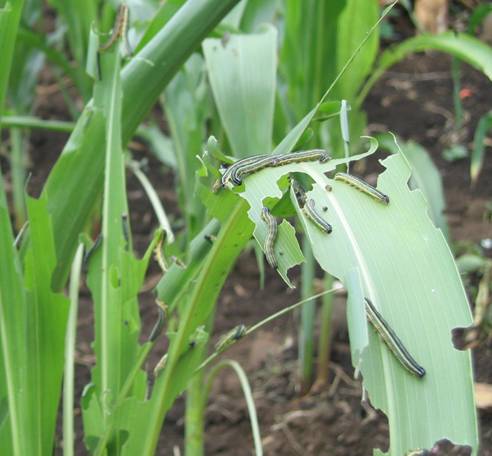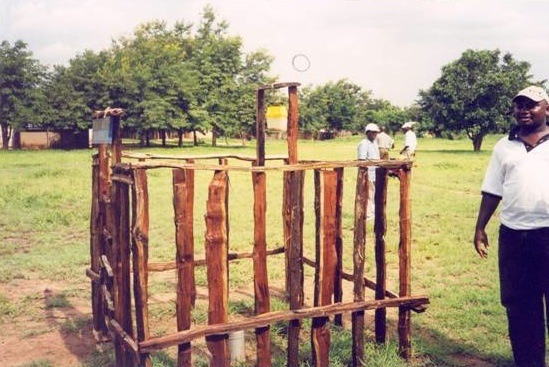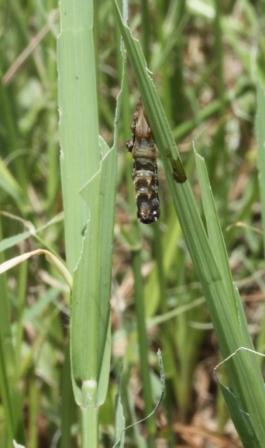
A recent international scientific meeting in Nairobi "Winning the war against armyworms" on 24-25th May marked the start of a major new DFID-funded Research Into Use initiative to control African armyworm in which NRI staff are playing a key role. The African armyworm (Spodoptera exempta) is a devastating pest of crops in Sub-Saharan Africa. Dense armies of caterpillars, up to 1000 per square metre, of this pest can appear without warning and voraciously attack and consume growing crops of maize, millet, sorghum, wheat, rice and pasture causing disastrous food shortages. In most years, hundreds of thousands of hectares of crops are destroyed mainly in the poorest countries of Sub Saharan Africa where food is already lacking for many people. In severe armyworm outbreak years, farmers and governments can be overwhelmed by the unpredictability and scale of armyworm attacks, and up to 70% of farmers lose crops as they cannot afford pesticides to control the pests.
To improve control of armyworm, governments in eastern and southern Africa are seeking a two pronged approach to reducing food losses to armyworm. The first is better forecasting of outbreaks to enable farmers to act in time and the second is to develop better control techniques that are cheaper and more sustainable than the use of imported synthetic pesticides.
To improve forecasting an NRI led research project under Dr John Holt developed and evaluated the use of a community based armyworm forecasting system (CBAF) in several countries in East Africa. These low-cost village forecasting systems were based on traps that used an armyworm specific pheromone originally developed by Professor Alan Cork and colleagues at NRI. This CBAF was shown to provide much more reliable and timely warning than the national trap network that was the source of previous forecasts helping communities to be better prepared for armyworm attacks (Mushobozi et al 2005, Holt et al., 2006).
In Tanzania, another project led by David Grzywacz of NRI and Wilfred Mushobozi of Pest Control Services Tanzania had developed and tested the use of a biological control agent, the armyworm nucleopolyhedrovirus (NPV). This NPV is a specific viral disease of armyworms that is harmless to humans other animals or insects but highly infectious and deadly to the armyworm. However the NPV appears unpredictably and is often absent when major armyworm outbreaks occur. The NRI team with Tanzanian colleagues and partners from Lancaster University have shown that it can be artificially propagated at low cost in Tanzania and then virus epidemics induced in armyworm by spraying outbreaks with the NPV. This spraying has been shown to kill armyworm as effectively as using synthetic pesticide (Grzywacz et al 2008) but at a lower cost and without the environmental issues associated with toxic chemical pesticides. With funding from the BBSRC and DFID, the team is currently exploring how best to predict and exploit NPV from natural disease outbreaks.
The new project "Safe and Affordable Armyworm Control Tools for Poor Farmers in East Africa" seeks to scale up the use of both CBAF and NPV in Tanzania and Kenya, the countries most frequently attacked by armyworm. An extensive programme of training and local sourcing of components for the CBAF will promote the forecasting system, while the building of a facility to produce the NPV in Tanzania will ensure increased supply of safe control. The project is to be implemented directly by Eco agri consult LTd, a local based company and pest control agencies with NRI providing technical expertise and support, with CABI leading the main project.
References
- Grzywacz, D., Mushobozi, W.L., Parnell, M., Jolliffe, F., and Wilson K., (2008). The evaluation of Spodoptera exempta nucleopolyhedrovirus (SpexNPV) for the field control of African armyworm (Spodoptera exempta) in Tanzania. Crop Protection, 27, 17-24.
- Holt, J., Mushobozi, W., Day, R.K., Knight, J.D., Kimani, M., Njuki, J. & Musebe, R. (2006). A simple Baysian network to interpret the accuracy of armyworm outbreak forecasts. Annals of Applied Biology 148, 141-146.
- Mushobozi WL, Grzywacz D, Musebe R, Kimani M & Wilson K (2005) New approaches to improve the livelihoods of poor farmers and pastoralists in Tanzania through monitoring and control of African armyworm, Spodoptera exampta. Aspects of Applied Biology 75: 37-45.
TV report on the project.
Youtube clips
Armyworm outbreak
Armyworm killed by NPV



